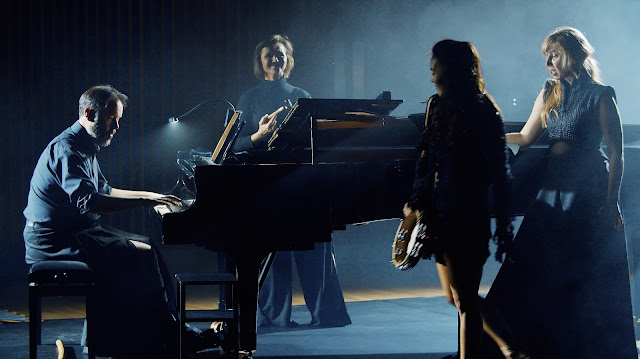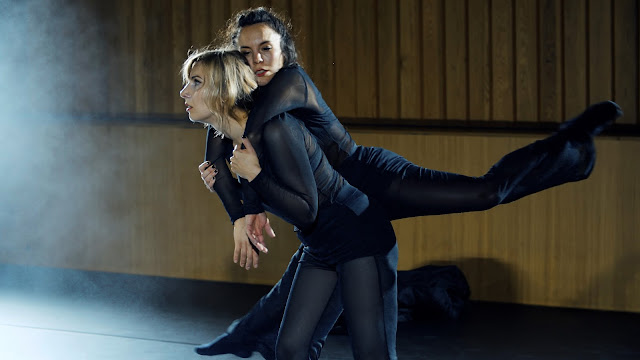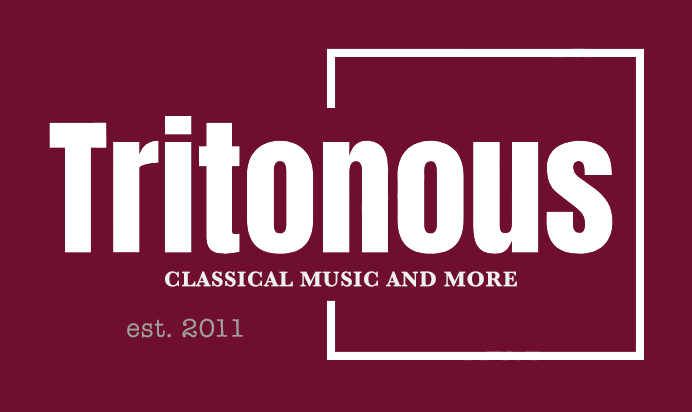 |
| Baba Yaga: Songs & Dances of Death – Sholto Kynoch, Ana Dordevic, Carola Schwab, Rowan Hellier – Oxford International Song Festival (Photo: TallWall Media) |
Baba Yaga: Songs and Dances of Death – Elena Langer, Mussorgsky, Dvorak, Janacek, Purcell, Britten, Heggie; Rowan Hellier, Sholto Kynoch, Ana Dordevic, Carola Schwab, Andreas Heise; Oxford International Song Festival at the Olivier Hall, St Edward’s School
Reviewed 22 October 2025
Something between a danced song-recital and music theatre, this remarkable evening explored the fascinating character of Baba Yaga from Slavic myth, embodied by three women including the astounding performance from Rowan Hellier both singing and dancing
Having focused on Shostakovich for the lunchtime and afternoon concerts at the Oxford International Song Festival on 22 October 2025 [see my review], the evening event kept the Slavic theme by turning its attention to Baba Yaga. In the Olivier Hall of St Edward’s School, the festival presented Baba Yaga: Songs & Dances of Death, a music theatre piece that featured mezzo-soprano Rowan Hellier and pianist Sholto Kynoch along with dancers Ana Dordevic and Carola Schwab. The evening was co-directed by Hellier and choreographer Andreas Heise [see my recent interview with Rowan Hellier for more background on the project].
This was something between a dance piece and a song recital, with Hellier moving alongside the two dances, with costumes and lighting by Sascha Thomsen and Helene Rindtorff. The piece flowed continuously for an hour and a quarter and explored various themes around Baba Yaga, a figure from Slavic folk lore who is by turns maiden, mother and crone. Our image of the witch Baba Yaga from Mussorgsky’s Pictures at an Exhibition (which was included in the evening) is only part of the story.
 |
| Baba Yaga: Songs & Dances of Death – Rowan Hellier, Ana Dordevic – Oxford International Song Festival (Photo: TallWall Media) |
The performance centred on two main works: songs from Mussorgsky’s Songs & Dances of Death were scattered throughout the evening whilst at the centre was the premiere of Elena Langer‘s song-cycle Lovely Weather for Witches.
Langer’s new cycle gathered together eight settings of Russian poets (Boris Pasternak, Sergei Yesenin, Alexander Blok, Anna Akhmatova, Marina Tsvetayeva) to create a sequence that meditated on women, witchcraft and the weather. This was the only part of the evening where Hellier used the printed music, and as she sang Dordevic and Schwab danced. Langer’s musical language here used textures and motifs that were both striking and memorable. The fifth song, Snow 2 was, quite rightly, used as a rather memorable intro and outtro for the evening, and the whole cycle had a sense of rightness about it. Whilst using the cycle in combination with dance was highly effective with Heise’s choreography bringing out interesting resonances, I would have liked to have heard it in concert so that I could read and study the words whilst listening.
Langer’s cycle formed Part Two of the evening, themed on Nature and Culture, the other parts were Part One, Life and Death, and Part Three, Male and Female, but there were interludes too. Threaded through the evening were songs from Mussorgsky’s Songs and Dances of Death, notably Trepak, Serenade and Field Marshall, alongside the piano solo of Baba Yaga from Pictures at an Exhibition. There was also Tchaikovsky’s song Baba Yaga.
But the evening cast its net widely, we had two of Dvorak’s Gypsy songs, ‘Songs my mother taught me’ and ‘Give a hawk a cage’, a movement from Janacek’s On an Overgrown Path along with two of his Moravian Folk Poetry in Song, an excerpt from Britten’s A Charm of Lullabies and ‘Snake’ from Jake Heggie’s Eve-Song, as well as a traditional Lithuanian song, a traditional Scottish song (sung by all three women as the three witches), and the witches dance from Purcell’s Dido and Aeneas.
Heise’s choreography brought out interesting resonances in the songs, with the three women entering and leaving as once, but then as the music unfolded they separated and each took a different focus. As a music theatre piece it was entrancing and engaging. Rowan Hellier’s achievement in conceiving and creating the work was stupendous. Her musical performance resonated enormously and the remarkable feat of combining this with dance was notable. But you did not notice the different moving parts, what the performers created was a remarkable synthesis.
Pianist Sholto Kynoch was certainly not a passive part of the evening. Wearing a custom designed costume, he played a wide range of music rather thrillingly displaying enormous sympathy for Langer’s evocative piano writing, bringing out the various cultural resonances in Mussorgsky music and more besides. But he was often part of the physical action, with the dancers playing around and on him as he played. A remarkable feat indeed.
As an evening about Baba Yaga it was, perhaps, less successful. Baba Yaga is a figure from Slavic folklore, and as Rowan Hellier explained to me when we met up, you don’t know whether she is good or bad. In some tales, she helps people and in others she hinders. She can be seen as an ogress, a snake, a death figure, the shadow self or a matriarchal ancestress.
We were sat in the dark, responding to Thomsen and Rindtorff’s atmospheric lighting which meant that we had no access to the printed programme. The words from the songs were projected, but the evening’s overarching themes rather took second place. I felt that the project could have been a bit more didactic, telling us what we were listening to and why in places. If you knew about Baba Yaga, then the result was an intriguing meditation on this fascinating figure, but if you did not know about her then the evening was more of a meditation on the role of women in folk poetry and lore.
By any standards this was a remarkable achievement and it was a shame that there was only one performance. The work was a co-production with Beethovenfest Bonn but really it needs to be presented more widely.
The blog is free, but I’d be delighted if you were to show your appreciation by buying me a coffee.
Elsewhere on this blog
- Focus on Shostakovich: tenor Oliver Johnston’s fearlessness & speaker Philip Ross Bullock in engaging form in Oxford – concert review
- Valentin Berlinsky: marking the centenary of founder and cellist of the Borodin String Quartet – concert review
- Thinking about sound: Grieg’s Lyric Pieces on a modern piano from Alexander Ullmann & on historic pianos with unequal temperament from Ziad Kreidy – record review
- Favourite songs & last words: Schubert weekend in Oxford with Nikola Hillebrand, Julius Drake, Thomas Oliemans & Paolo Giacometti – review
- Gluck Arias: Ann Hallenberg’s latest disc with The Mozartists is the result of her long and fruitful relationship with conductor Ian Page – interview
- Not so slight & surprisingly experimental: the Royal Opera & La Nuova Music bring a touch of 1930s glamour to Handel’s Giustino – opera review
- Berlin Diary: Tony Cooper finds time to fit in a thrilling concert by the Berlin Philharmonic & Daniele Gatti – review
- There was nothing semi- about the performances: we were drawn into this quirky world: ENO’s production of Britten’s Albert Herring – review
- In the moment: John Butt & the OAE explore the glorious richness of Handel’s Solomon as the opener to their anniversary season – review
- Home


%20Anthony%20Robling.jpg?w=670&resize=670,446&ssl=1)

,%20Giorgio%20Vasari,%20Palazzo%20Vecchio,%20Florence.jpg?w=670&resize=670,446&ssl=1)




